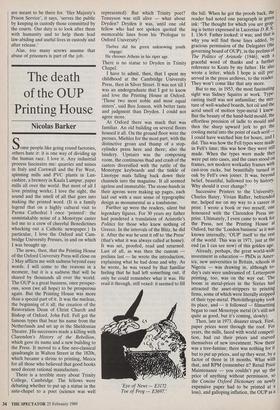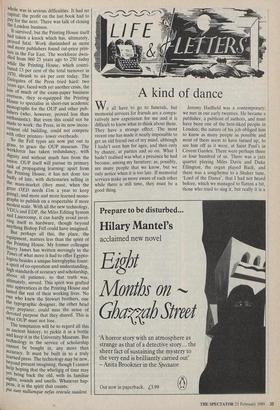The death of the OUP Printing House
Nicolas Barker
Some people like going round factories, others hate it: it is one way of dividing up the human race. I love it. Any industrial process fascinates me: quarries and mines in Italy and Cornwall and the Far West, spinning mills and PVC plants in Lan- cashire, a brewery in Kuala Lumpur, paper mills all over the world. But most of all I love printing works; I love the sight, the sound and the smell of all that goes into making the printed word. (It is a family legend that on a highly cultural visit to Parma Cathedral I once 'pointed': the unmistakable noise of a Monotype caster led me to a crew of cheerful Benedictines whacking out a Catholic newspaper.) In particular, I love the Oxford and Cam- bridge University Presses, in and on which I was brought up.
The news, then, that the Printing House of the Oxford University Press will close on 2 May afflicts me with sadness beyond easy words. I will come to the reasons in a moment, but it is a sadness that will be shared by thousands all over the world. The OUP is a great business, once prosper- ous, soon (we all hope) to be prosperous again. But the Printing House was more than a special part of it. It was the nucleus, the beginning of it all, the creation of the Restoration Dean of Christ Church and Bishop of Oxford, John Fell. Fell got the famous types that bear his name from the Netherlands and set up in the Sheldonian Theatre. Ills successors made a killing with Clarendon's History of the Rebellion, which gave its name and a new building to the Press. It moved to a fine neo-classical quadrangle in Walton Street in the 1820s, which became a shrine to printing, Mecca for all those who believed that good books need decent rational manufacture.
There is a terrible story about Trinity College, Cambridge. The fellows were debating whether to put up a statue in the ante-chapel to a poet (science was well represented). But which Trinity poet? Tennyson was still alive — what about Dryden? Dryden it was, until one old fellow who had not spoken quoted the memorable lines from his 'Prologue to Oxford University':
Thebes did his green unknowing youth engage:
He chooses Athens in his riper age.
There is no statue to Dryden in Trinity Chapel.
I have to admit, then, that I spent my childhood at the Cambridge University Press, then in Silver Street. It was not till I was an undergraduate that I got to know and love the Printing House at Oxford. `Those two most noble and most equal sisters', said Ben Jonson, with better taste and judgment than Dryden. I could not agree more.
At Oxford there was much that was familiar. An old building on several floors housed it all. On the ground floor were the presses, Miehles for the most part, with the distinctive groan and thump of a stop- cylinder press here and there; also the bindery. Upstairs was the composing room, the continuous thud and crash of the casters diversified with the rattle of the Monotype keyboards and the tinkle of Linotype mats falling back down their channels into the magazine. It all seemed ageless and immutable. The stone-hands in their aprons were making up pages, each laid out with a sure sense of typographic design as monumental as a tombstone.
Further up were the readers, silent but legendary figures. For 30 years my father had pondered a translation of Aristotle's Politics for those who knew nothing of Greece. In the intervals of the Blitz, he did it. After the war he sent it off to 'the Press' (that's what it was always called at home). It was set, proofed, read and returned. Last of all, as was then the custom prelims last — he wrote the introduction, explaining what he had done and why. As he wrote, he was vexed by that familiar feeling that he had left something out, if only he could remember what it was. He read it through, still vexed: it seemed to fill `Eye of Newt — E3172 Toe of Frog — E3697.' the bill. When he got the proofs back, the reader had noted one paragraph in green ink: 'The thought for which you are grop- ing is better expressed in Lucretius D R. I. 136-9. Father looked: it was; and that is why you will find those lines added, by gracious permission of the Delegates (the governing board of OUP), in the prelims of The Politics of Aristotle (1946), with a graceful word of thanks and a further reference to Keats by my father. He also wrote a letter, which I hope is still pre- served in the press archives, to the reader. They won't come like that any more.
But to me, in 1953, the most fascinating sight was Sidney Squires at work. Type- casting itself was not unfamiliar; the mix- ture of well-washed boards, hot oil and the acrid smell of molten type-metal I knew. But the beauty of the hand-held mould, the effortless precision of ladle to mould and then the sharp upward jerk to get the cooling metal into the point of each serif I could have watched him for hours, and I did. This was how the Fell types were made in Fell's time; this was how they were still made. When the types were made they were put into cases, and the cases stood on frames, not modern workaday frames with cast-iron racks, but beautifully turned in oak by Fell's own joiner. It was, beyond belief, beautiful, hallowed too by history. Why should it ever change?
Successive Printers to the University, Charles Batey, Vivian Ridler, befriended me, helped me on my way to a career in print. I wrote a book or two myself, one honoured with the Clarendon Press im- print. Ultimately, I even came to work for the Press, not the Printing House at Oxford, but the 'London business' as it was known internally, 'OUP' itself to the rest of the world. This was in 1971, just at the end (as I can see now) of this golden age. Already, perhaps, the great world-wide investment in education — PhDs in Amer- ica, new universities in Britain, schools in Nigeria — was drawing in, although to- day's cuts were undreamed of. Letterpress printing, too, was on the way out. The boom in metal-prices in the Sixties had attracted the asset-strippers to printing firms, some of which were literally stripped of their type-metal. Photolithography took its place, and — it followed — filmsetting began to oust Monotype metal (it's still not quite as good, but it's coming, slowly).
Then, late in 1973, disaster struck. First, paper prices went through the roof. For years, the mills, faced with world competi- tion, had cut their prices and starved themselves of new investment. Now there was a tree-famine; there was nothing for it but to put up prices, and up they went, by a factor of three in 18 months. What with that, and RPM (remember it? Retail Price Maintenance — you couldn't put up the price of anything without permission, so the Concise Oxford Dictionary on newly expensive paper had to be printed at a loss), and galloping inflation, the OUP as a whole was in serious difficulties. It had no capital: the profit on the last book had to Pay for the next. There was talk of closing the London business. It survived, but the Printing House itself had taken a knock which has, ultimately, proved fatal. Work diminished as more and more publishers found cut-price prin- ters in the Far East. The workforce dwin- dled from 960 25 years ago to 250 today while the Printing House, which contri- buted 13 per cent of the total turnover in ,1970, shrank to six per cent today. The Delegates of the Press tried hard: two Years ago, faced with yet another crisis, the loss of much of the exam-paper business overseas, they re-equipped the Printing House to specialise in short-run academic Monographs for the OUP and other pub- lishers (who, however, proved less than enthusiastic). But even this could not be made to work: the Press, in its now incon- venient old building, could not compete with other printers, lower overheads. So the Fell types are now put out to grass, to grace the OUP museum. The workforce has taken redundancy, with dignity and without much fuss from the anion. OUP itself will pursue its primary task of propagating learning: apart from the Printing House, it has not done too badly of late, with dictionaries selling in the mass-market (they must, when the great OED needs Lim a year to keep going), and more and more learned mono- graphs to publish on a respectable if more modest scale. With all the new technology, VDUs and EDP, the Miles Editing System and Lasercomp, it can hardly avoid invol- ving itself in hardware, though beyond anything Bishop Fell could have imagined. But perhaps all this, the place, the equipment, matters less than the spirit of the Printing House. My former colleague Harry James has written movingly in the Times of what more it had to offer Egypto- logists besides a unique hieroglyphic fount: a spirit of co-operation and understanding, high standards of accuracy and scholarship, above all patience, so that truth was, ultimately, served. This spirit was grafted ,into apprentices in the nting Huse and lasted the rest of their working lioves. No °ne who knew the Stewart brothers, one the typographic designer, the other head Copy preparer, could miss the sense of devoted purpose that they shared. This is What OUP must not lose.
The temptation will be to regard all this as ancient history, to pickle it in a bottle and keep it in the University Museum. But technology in the service of scholarship cannot be bought in, any more than accuracy. It must be built in to a truly learned press. The technology may be new, beyond present imagining, though I cannot help hoping that the whirligig of time may Yet bring back the old, with its familiar sights, sounds and smells. Whatever hap- Pens, it is the spirit that counts: Pia suns nullumque nefas oracula suadent.

















































 Previous page
Previous page